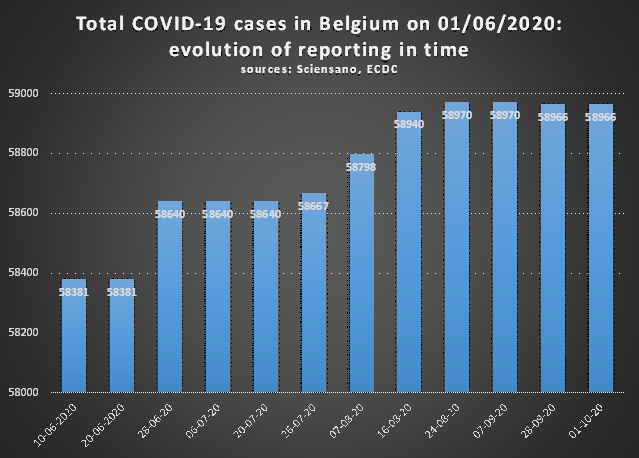A numbers man’s nightmare
Most people find it hard to believe that North Korea has had so far only 1 case of corona. Most people find it equally hard to believe that suspected Patient Number One was a man who had defected to South Korea three years ago, then showed remorse, and illegally re-entered this year the country while carrying with him the “vicious virus”. But fact checking is hardly an option here.
In less hermetic countries, attempts to falsify corona statistics are spotted easier. BBC Persia revealed earlier how the Iranian government had underreported the number of corona deaths in the country. The true figure was at that moment three times higher.
More recently, Turkey’s health minister was accused of cooking the corona books, by omitting all asymptomatic cases and inflating the number of PCR-tests performed. On September 10, the official government data showed 1512 new cases, along with 112,000 tests carried out. According to the opposition, the true figures that day were 29,377 and 152,000, respectively.
Tanzania has stopped reporting corona cases and deaths altogether. The country’s president, Mr John Magufuli, had repeatedly fulminated against what he perceived as unreliable tests. The final blow to reporting came on May 8, after a goat, a quail and a papaya had supposedly been tested positive. One month later, Mr Magufuli declared his country COVID-19 free.
However, wrong numbers are usually not the result of deliberately doctoring data. More often than not, they stem from administrative mistakes. Sometimes these mistakes are palpable, for example when Peru reports more cases than tests (people positive for antibodies and via PCR are counted twice, or more.)
Several countries have announced systematic reporting mistakes, which they have subsequently corrected in one go. Sometimes you could hardly talk about mistakes. Early in the pandemic, Luxembourg had initiated an ambitious and vast testing program. The country set out to test all of its 600,000 inhabitants. Luxembourg also counts more than 200,000 cross-border workers, and the program generously included these frontier workers. The country has become world leading in the testing department.
But the policy backfired. After Luxembourg signaled earlier than its neighboring countries the upward trend of infections, the country was singled out as a hotspot. Our site had half-jokingly calculated that if 1926 of Luxembourg’s positive cases could be attributed to Belgian frontier workers, the balance between the two countries would be restored. On August 28, the ECDC subtracted at the request of the Luxembourgish health authorities 1385 cases which concerned cross-border workers.
On other occasions, mistakes are undeniable. Only a few days ago, the UK admitted to underreporting the number of corona cases. At least 16,000 corona cases have been missed because of an Excel hiccup.
In another matter, the very same UK had decided early August to reduce its death toll by more than 5,000. People who had died with, but not of the virus, were no longer counted as COVID-19 victims. Although in itself a correct move, it was also a bold one, considering the much larger number of excess deaths seen in the UK since mid-March.
On September 26, as we pointed out elsewhere, The Netherlands almost casually included 21 people who had all died months earlier in its daily COVID-19 death toll. The Dutch state institute RIVM added that it would still subtract 86 people who had tested positive for the virus, but who had died of other causes. The Dutch approach here is reminiscent of the British one. From the start of the pandemic until now, the Netherlands have an excess mortality 1.5 times the official corona death toll.
But Belgium beats them all. Officially, Sciensano, the country’s responsible institute, has granted itself a four-day span to finalize its figures. You would then expect these data to be carved in stone. Reality is different.
Most countries, even entire continents (Africa, Oceania) report their data and then don’t change a single digit anymore, but not Belgium. Let’s take as an example the number of cases until June 1st. Based on Sciensano’s commitment, the numbers should have been fixed on June 5th. They were not. In fact, they have been constantly adjusted until now. At arbitrary moments during the past months we have looked at this parameter. We see an ongoing sequence of small, silent changes, even 4 months later, barely noticeable, but real.
Why is this, what is driving Belgium? Is it a zealous drive for perfection, to the despair, yet also awe of the number crunchers? An example for the world? Or is it the sign of a slow, meandering bureaucratic machinery? The jury is still out on this one.

Sources data
on COVID-19 cases and deaths per country: European Centre for Disease Prevention and Control
on excess mortality: The Economist, Tracking covid-19 excess deaths across countries
(rvdk)

